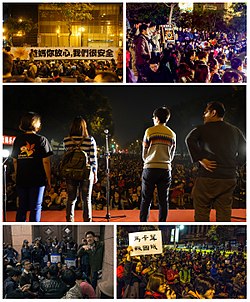| Sunflower Student Movement | |||
|---|---|---|---|
 | |||
| Date | March 18 – April 10, 2014 (23 days) | ||
| Location | 25°2′40″N 121°31′10″E / 25.04444°N 121.51944°E | ||
| Caused by | Cross-Strait Service Trade Agreement | ||
| Goals |
| ||
| Methods | Sit-ins, occupation, strike actions, demonstrations, online activism, protest marches, civil disobedience, civil resistance, student activism | ||
| Resulted in | Implementation of the Cross-Strait Service Trade Agreement halted | ||
| Parties | |||
| |||
| Lead figures | |||
Ma Ying-jeou (President) | |||
| Number | |||
| |||
| Sunflower Student Movement | |||||||||||
|---|---|---|---|---|---|---|---|---|---|---|---|
| Traditional Chinese | 太陽花學運 | ||||||||||
| Simplified Chinese | 太阳花学运 | ||||||||||
| Literal meaning | Sunflower Student Movement | ||||||||||
| |||||||||||
The Sunflower Student Movement is associated with a protest movement driven by a coalition of students and civic groups that came to a head between March 18 and April 10, 2014, in the Legislative Yuan and later, the Executive Yuan of Taiwan.[3][4][5] The activists protested the passage of the Cross-Strait Service Trade Agreement (CSSTA) by the then-ruling Kuomintang (KMT) at the legislature without a clause-by-clause review.
The protesters perceived the trade pact with the People's Republic of China would hurt Taiwan's economy and leave it vulnerable to political pressure from Beijing, while advocates of the treaty argued that increased Chinese investment would provide a "necessary boost" to Taiwan's economy, that the still-unspecified details of the treaty's implementation could be worked out favorably for Taiwan, and that to "pull out" of the treaty by not ratifying it would damage Taiwan's international credibility.[6][7][8] The protesters initially demanded the clause-by-clause review of the agreement be reinstated[9] but later changed their demands toward the rejection of the trade pact, the passing of legislation allowing close monitoring of future agreements with China, and citizen conferences discussing constitutional amendments.[10] While the Kuomintang was open to a line-by-line review at a second reading of the agreement,[11][12] the party rejected the possibility that the pact be returned for a committee review.[13]
The KMT backed down later and said that a joint review committee could be formed if the Democratic Progressive Party (DPP) agreed to participate in the proceedings. That offer was rejected by the DPP, which asked for a review committee on all cross-strait pacts, citing "mainstream public opinion."[14] In turn, the DPP proposal was turned down by the KMT.[15][16]
The movement marked the first time that the Legislative Yuan had been occupied by citizens.[17][18] Many Sunflower student activists became further involved in Taiwan's politics in the aftermath.[6][19]
- ^ Hsu, Jenny W. (April 1, 2014). "Young Protesters Shaking Up Taiwan's China Policy". The Wall Street Journal. Archived from the original on April 5, 2014. Retrieved April 3, 2014.
- ^ Feng, John Scot (March 31, 2014). "Activist profiles: the leaders of the Sunflower Student Movement". Central News Agency. Archived from the original on May 2, 2019. Retrieved April 3, 2014.
- ^ Ramzy, Austin (March 22, 2014). "As Numbers Swell, Students Pledge to Continue Occupying Taiwan's Legislature". The New York Times. Archived from the original on March 22, 2014. Retrieved March 22, 2014.
- ^ 【直擊】警提升府維安 對戰一觸即發. Apple Daily (in Chinese). March 20, 2014. Archived from the original on October 20, 2017. Retrieved March 20, 2014.
- ^ Tseng, Ying-yu; Hsu, Elizabeth (March 18, 2014). "Protesters break police line, storm Legislature". Focus Taiwan. Central News Agency. Archived from the original on September 9, 2019. Retrieved March 19, 2014.
- ^ a b "Protesters occupy Taiwan parliament over China trade deal". BBC. March 19, 2014. Archived from the original on May 4, 2019. Retrieved March 19, 2014.
- ^ 鄭秀玲 (July 29, 2013). 兩岸服貿協議對我國的衝擊分析 (in Chinese). Slideshare. Archived from the original on May 27, 2016. Retrieved March 19, 2014.
- ^ 鄭秀玲 (September 13, 2013). "服貿自救寶典(I) : 服貿協議將對誰有影響" (in Chinese). Slideshare. Archived from the original on December 7, 2016. Retrieved March 19, 2014.
- ^ Cole, J. Michael (March 20, 2014). "Taiwanese Occupy Legislature Over China Pact". The Diplomat. Archived from the original on April 25, 2019. Retrieved March 20, 2014.
- ^ Tseng, Ying-yu; Chuan, Ku; Hou, Elaine (March 23, 2014). "Protesters lay out demands, vow to continue occupation of Legislature". Central News Agency. Archived from the original on August 28, 2019. Retrieved March 28, 2014.
- ^ Brown, Sophie; Li, Zoe (March 24, 2014). "Taiwan police clash with students in protests over trade deal". CNN. Archived from the original on March 5, 2016. Retrieved March 24, 2014.
- ^ Tang, Pei-chun; Wu, Lilian (March 24, 2014). "KMT aiming for item-by-item review of pact at floor session". Central News Agency (Republic of China). Archived from the original on May 2, 2019. Retrieved March 24, 2014.
- ^ Shih Hsiu-chuan (March 22, 2014). "LEGISLATIVE SIEGE: KMT open to line-by-line review of pact". Taipei Times. Archived from the original on May 2, 2019. Retrieved March 26, 2014.
- ^ Wang, Chris (March 28, 2014). "TRADE PACT SIEGE: KMT says open to making concessions". Taipei Times. Archived from the original on May 2, 2019. Retrieved March 28, 2014.
- ^ Loa, Iok-sin (March 29, 2014). "Jiang defends eviction, rejects demands". Taipei Times. Archived from the original on May 2, 2019. Retrieved March 29, 2014.
- ^ Wang, Chris (March 29, 2014). "DPP says no more interparty talks". Taipei Times. Archived from the original on May 2, 2019. Retrieved March 29, 2014.
- ^ Lin, Adela; Culpan, Tim (March 19, 2014). "Taiwan Students Occupy Legislature Over China Pact". Bloomberg. Bloomberg L. P. Archived from the original on October 6, 2014. Retrieved March 22, 2014.
- ^ 陳沂庭 (March 19, 2014). 群眾占領議場 國會史上首次 (in Chinese). Radio Taiwan International. Archived from the original on March 19, 2014. Retrieved March 19, 2014.
- ^ "Taiwan's Sunflower Protests: A Q&A with Shelley Rigger". Dissent Magazine. Archived from the original on September 30, 2023. Retrieved September 30, 2023.